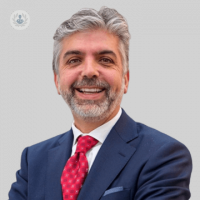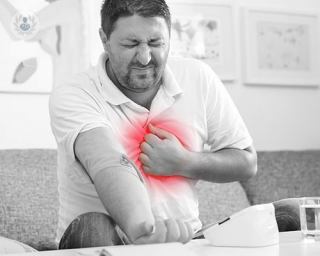Aortopathy
Mr George Asimakopoulos - Cardiothoracic surgery
Created on: 11-07-2017
Updated on: 05-24-2023
Edited by: Conor Dunworth
What is aortopathy?
Aortopathy simply means any disease of the aorta, the main artery in the body, which includes aortic enlargement, aortic aneurysms and aortic dissection. Disease of the aorta within the chest is called thoracic aortic disease.
There are two main types or aortopathy:
- Thoracic aortic enlargement progressing to life-threatening acute aortic dissection
- Thoracic aortic dissection (tearing in the lining of the artery) in the absence of aortic enlargement. A tear in the lining of the artery allows blood to flow between layers of the artery, rupture of the tear can lead to bleeding outside of the aorta.
What are the symptoms of aortopathy?
Often enlargement of the aorta is not associated with any symptoms, so patients may not even be aware that they have a heart problem. Sometimes the following symptoms might be experienced with aortic dissection or a tear in the lining of the aorta:
- Back pain
- Sudden chest pain
- Pain in the neck or jaw
- Low blood pressure
- Severe abdominal pain
- Nausea and vomiting
- Dizziness, weakness or fainting
- Sweating and a rapid heartbeat
How is aortopathy diagnosed?
If a family member has aortopathy, then close family members may be screened by DNA testing to see if they carry the predisposing gene. Aortopathy can then be diagnosed early in those that are thought to be at risk, by having yearly ultrasound pictures taken of the heart with an echocardiogram, or MRI scan or CT scan.
In those who have no family members with the condition, diagnosis can often be by chance when the patient is being screened for other health issues. Other times there may be physical signs and symptoms that make diagnosis easier. The doctor will look at family history, carry out a physical examination and will perform a DNA screening test called an aortic disease panel if aortopathy is suspected.
What causes aortopathy?
20% of cases are due to inherited genes. There are over 50 genes that are known to predispose people to aortic aneurysms. The genes cause proteins that make up the aortic wall to be produced in smaller numbers, which weakens the wall and leads to tearing and expansion of the artery.
Certain conditions that predispose people to aortopathy include:
- Marfan syndrome, a connective tissue disorder
- Loeys-Dietz
- Vascular Ehlers-Danlos
- Aneurysm-osteoarthritis
- Turner syndrome
- Bicuspid aortic valve
- Coarctation of the aorta, which occurs in 6-8% of those with congenital heart disease
- Tetralogy of Fallot
Risk factors include:
- Increasing age
- Pregnancy
- High blood pressure
- Atherosclerosis or hardening of the arteries
Can aortopathy be prevented?
There is preventative medication that can help to prevent aortic enlargement in people who are at risk, like those who carry a gene that predisposes them to the condition or who have a family member with the condition. Regular ECGs, blood pressure monitoring and MRI and CT scans should be carried out.
Lifestyle factors can also help towards prevention, such as:
- Avoiding smoking
- Healthy diet and regular aerobic exercise
- Good blood pressure control
- Maintaining a healthy weight
- Taking blood pressure medication as prescribed
- Reporting any cardiac symptoms to your doctor
How is aortopathy treated?
There is no cure at present for aortopathy, but the condition can be treated with thoracic aortic surgery to prolong the person's life. Surgery has a 97-99% success rate and often extends the person’s lifespan by 20 to 25 years.
There are two main types of surgery:
- Replacement of the defective aortic wall
- A procedure called PEARS that plants a mesh in the aorta to prevent aneurysms
Yearly scans of the aorta will be recommended after the surgery.


